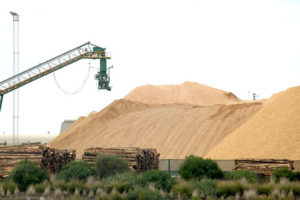Hardwood chip deliveries to China fell to their lowest quarterly total in two years in the 4Q 2019. At 2.771 million bone dried metric tons (bdmt), deliveries were still substantial, albeit almost 13% lower than the previous quarter. Source: Tim Woods IndustryEdge
The major supplier, Vietnam, saw its contribution continue on trend at 1.600 million bdmt, meaning it was other significant suppliers whose volumes reduced.
Australian supplies, perennially the second-largest volume into China, were hit hardest, falling to 0.685 million bdmt for the quarter, down 27.6% from the prior quarter and the lowest since 3Q 2015.
In a trade that really is Vietnam first, Australia second, and anyone else third, the two major suppliers delivered a little more than 82% of total supply in 4Q. Other contributors including Chile, Thailand, and Brazil also saw their supply reduced, though their declines were not as large as Australia’s.
The drivers for lower total shipments to China include slowing demand for printing and communication grade papers, as well as a general economic slowdown in China. Most significant though, has been the differential between hardwood woodchip prices on the one hand and hardwood pulp prices on the other.
At first glance, this seems like an abnormal situation; raw material prices growing as finished product prices crash.
Sustaining higher hardwood chip prices as the pulp price tapered was strategically important for both hardwood chip sellers and buyers. For sellers, the delay in sharing in the cyclical price rises understandably provided incentive to sustain higher prices when they were achieved.
The position of buyers was even more strategic. Having agreed over recent years to longer-term supply arrangements as a means of ensuring they have access to supply into the future, Chinese pulp mills appear to have absorbed the higher cost of woodchips to maintain access to that supply into the future.
For buyers, the risk of being unable to secure stable resource could reduce their capacity to manufacture the maximum possible volume of pulp when the market next hits a peak. New sources of viable fibre are difficult to find and are quickly snapped up in a global market that continues to grow.
An IndustryEdge free white paper has a more detailed report this can be found at https://offers.forest2market.com/en/industryedge-wood-market-edge?hsCtaTracking=539bb9ad-4c63-4811-b8ad-519f6eaea943%7C2ba35956-a547-42b0-853d-e2e30b6e0167








